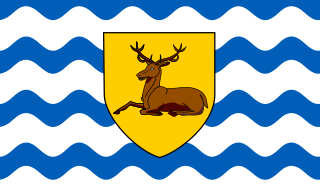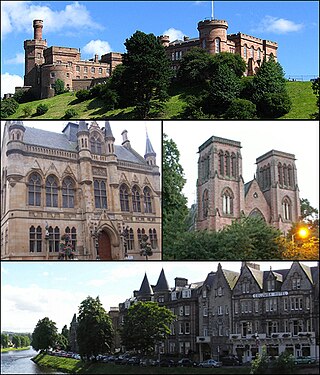
The Royal Caledonian School was a residential home and school for Scottish orphans, initially in London and subsequently in Bushey, Hertfordshire.

The Royal Caledonian School was a residential home and school for Scottish orphans, initially in London and subsequently in Bushey, Hertfordshire.
The Caledonian Asylum was launched by members of the Highland Society of London in 1815 to provide a home and education for Scottish children in London who had been orphaned in the Napoleonic Wars. John Galt, the novelist, became secretary to the Asylum in 1815. The first Asylum was at 16 Cross Street, [1] Hatton Garden, London from December 1819 until 1828 when it relocated to Copenhagen Fields, Islington. [2] Its long residence in Islington resulted in the naming of Caledonian Market and the Caledonian Road. [3] In 1852 Queen Victoria became Patron and the Asylum was renamed the Royal Caledonian Schools, although legally it was and still is the "Caledonian Asylum". [3] At that time it catered for about 70 boys and 50 girls. [4] The Asylum's band occasionally played at charitable and other events. [4] [5]

By the late 19th century the Islington site, near to Pentonville Prison, was recognised as unsuitable, and a new boarding school was built in Bushey, Hertfordshire, from 1902. The Caledonian Estate was built on the school's site in Caledonian Road. Bricks from the old Caledonian Asylum were used to build two blocks of flats in Widdenham Road, London N7, known collectively as Loraine Mansions. [6] The Royal Caledonian offered education until 1948, after which resident children received their education at local schools, in later years Queens' School which lies adjacent on Aldenham Road. [7]
In 1996 the premises were sold to the Purcell School. The proceeds of the sale were used for the charity to operate as the Royal Caledonian Education Trust, which continues to provide support to "children (no age limit) of Scots who have served in the Armed Forces, or the children of poor Scots living in the London area". Another objective is to allow the children of Scots serving in the armed forces a level of continuity in their education despite the frequent re-posting of their parents. [8]

Hertfordshire is one of the home counties in southern England. It borders Bedfordshire and Cambridgeshire to the north, Essex to the east, Greater London to the south, and Buckinghamshire to the west. For government statistical purposes, it forms part of the East of England region.

Inverness is a city in the Scottish Highlands. It is the administrative centre for The Highland Council and is regarded as the capital of the Highlands. Historically it served as the county town of the county of Inverness-shire. Inverness lies near two important battle sites: the 11th-century battle of Blàr nam Fèinne against Norway which took place on the Aird, and the 18th century Battle of Culloden which took place on Culloden Moor. It is the northernmost city in the United Kingdom and lies within the Great Glen at its northeastern extremity where the River Ness enters the Beauly Firth. At the latest, a settlement was established by the 6th century with the first royal charter being granted by Dabíd mac Maíl Choluim in the 12th century. Inverness and Inverness-shire are closely linked to various influential clans, including Clan Mackintosh, Clan Fraser and Clan MacKenzie.

Watford is a town and borough in Hertfordshire, England, 15 mi (24 km) northwest of Central London, on the River Colne.

Bushey is a town in the Hertsmere borough of Hertfordshire in the East of England. It had a population of 25,328 in the 2011 census. Bushey Heath is a large neighbourhood south east of Bushey on the boundary with the London Borough of Harrow reaching elevations of 165 metres (541 ft) above sea level.
Reed's School is an independent secondary boarding school for boys with a mixed sixth form located in Cobham, Surrey, England. There are currently around 700 day pupils and 100 full-time boarders. The school was founded in 1813, by Andrew Reed and incorporated by Act of Parliament in 1845 under the presidency of the Archbishop of Canterbury, the Duke of Wellington and the Marquess of Salisbury. From 1951 until her death in 2022 Queen Elizabeth II acted as the school's 15th patron and visited the school twice, in 1997 and in 2014, as the reigning monarch. Alumni of the school are known as 'Old Reedonians'.

Caledonian Sleeper is the collective name for overnight sleeper train services between London and Scotland, in the United Kingdom. It is one of only two currently operating sleeper services on the railway in the United Kingdom, the other being the Night Riviera which runs between London and Penzance.

Dunkeld is a town in Perth and Kinross, Scotland. The location of a historic cathedral, it lies on the north bank of the River Tay, opposite Birnam. Dunkeld lies close to the geological Highland Boundary Fault, and is frequently described as the "Gateway to the Highlands" due to its position on the main road and rail lines north. Dunkeld has a railway station, Dunkeld & Birnam, on the Highland Main Line, and is about 25 kilometres north of Perth on what is now the A9 road. The main road formerly ran through the town, however following modernisation of this road it now passes to the west of Dunkeld.

Andrew Reed was an English Congregational minister and hymnwriter, who became a prominent philanthropist and social reformer. He was the father of Sir Charles Reed and grandfather of Talbot Baines Reed.
Queens' School, near Watford, Hertfordshire, is a partially selective secondary school and sixth form with academy status. It currently is a specialist science and sports college.

The Royal Masonic School for Boys was an English independent school for boys at Bushey in Hertfordshire.
St Margaret's School is an independent boarding and day school co-educational aged 2–18 in Bushey, Hertfordshire.

Caledonian Road passes for about a mile and a half north–south through the London Borough of Islington. It connects North London, from Camden Road near its junction with Holloway Road, and central London's Pentonville Road in the south. It is known colloquially as the "Cally" and forms the entirety of the A5203.
This article provides brief details of primary schools in the borough of Watford in Hertfordshire, England, United Kingdom. Some Watford children attend schools in the neighbouring boroughs of Three Rivers and Hertsmere.
The Grange Academy is a co-educational secondary school and sixth form located in Bushey in the English county of Hertfordshire.

Thomas Atholl Robertson was a Scottish fine arts printer and publisher and Liberal politician.
The 2013 Birthday Honours were appointments by some of the 16 Commonwealth realms of Queen Elizabeth II to various orders and honours to reward and highlight good works by citizens of those countries. The Birthday Honours are awarded as part of the Queen's Official Birthday celebrations during the month of June. The Queen's Birthday Honours were announced on 15 June 2013 in the United Kingdom, on 10 June 2013 in Australia, on 3 June 2013 in New Zealand, and on 15 June 2013 in Grenada, Papua New Guinea, Solomon Islands, Tuvalu, Saint Lucia and Belize.
The 2015 Queen's Birthday Honours are appointments by some of the 16 Commonwealth realms of Queen Elizabeth II to various orders and honours to reward and highlight good works by citizens of those countries. The Birthday Honours are awarded as part of the Queen's Official Birthday celebrations during the month of June. The Queen's Birthday Honours were announced on 1 June 2015 in New Zealand, on 8 June in Australia, and on 12 June in the United Kingdom, in Grenada, Papua New Guinea, Solomon Islands, Tuvalu, Saint Lucia and Belize.
The 2016 Queen's Birthday Honours are appointments by some of the 16 Commonwealth realms of Queen Elizabeth II to various orders and honours to reward and highlight good works by citizens of those countries. The Birthday Honours are awarded as part of the Queen's Official Birthday celebrations during the month of June. The Queen's Birthday Honours were announced on 6 June 2016 in New Zealand and 10 June in the United Kingdom.
The 2021 New Year Honours are appointments by some of the 16 Commonwealth realms to various orders and honours to recognise and reward good works by citizens of those countries. The New Year Honours are awarded as part of the New Year celebrations at the start of January and those for 2021 were announced on 30 December 2020.
The Royal Caledonian Asylum, Copenhagen Fields, founded 1808, provides in like manner for 72 boys and 47 girls, children of Scotchmen. They are clad in what is called the Highland garb, and have a band of music and some pipers, who occasionally attend charitable festivals.
MR. PUNCH presents his compliments to the Governors of the Caledonian Asylum, and begs to know what amount of contribution was paid to their funds by the juggler at the Lyceum for the loan of the "fourteen orphans in full Scottish costume," the orphans whose "fathers have recently perished while defending Sebastopol?" Mr. Punch learns from the printed puff, that the juggler himself "who was also attired in the dress of his native land, the MACGREGOR tartan — made a very touching speech concerning them, which enlisted the entire sympathy of the audience." It may be all very proper that these poor children should be occasionally regaled with wine and cakes; but, why for the profit of a juggler, should they — like the animals at the Park — have their feeding time in public ? The conjuror himself only carries out his trade. He, of course, would ply his gilt balls and shuffle his cards for the penny's-worth in a hospital; but Mr. Punch must, in conclusion, put it to the Governors of the Caledonian Asylum, whether they do not, at such a time, betray a sacred trust, when they suffer the orphans of their guardianship to be turned into the ready-money tools of the mountebank?